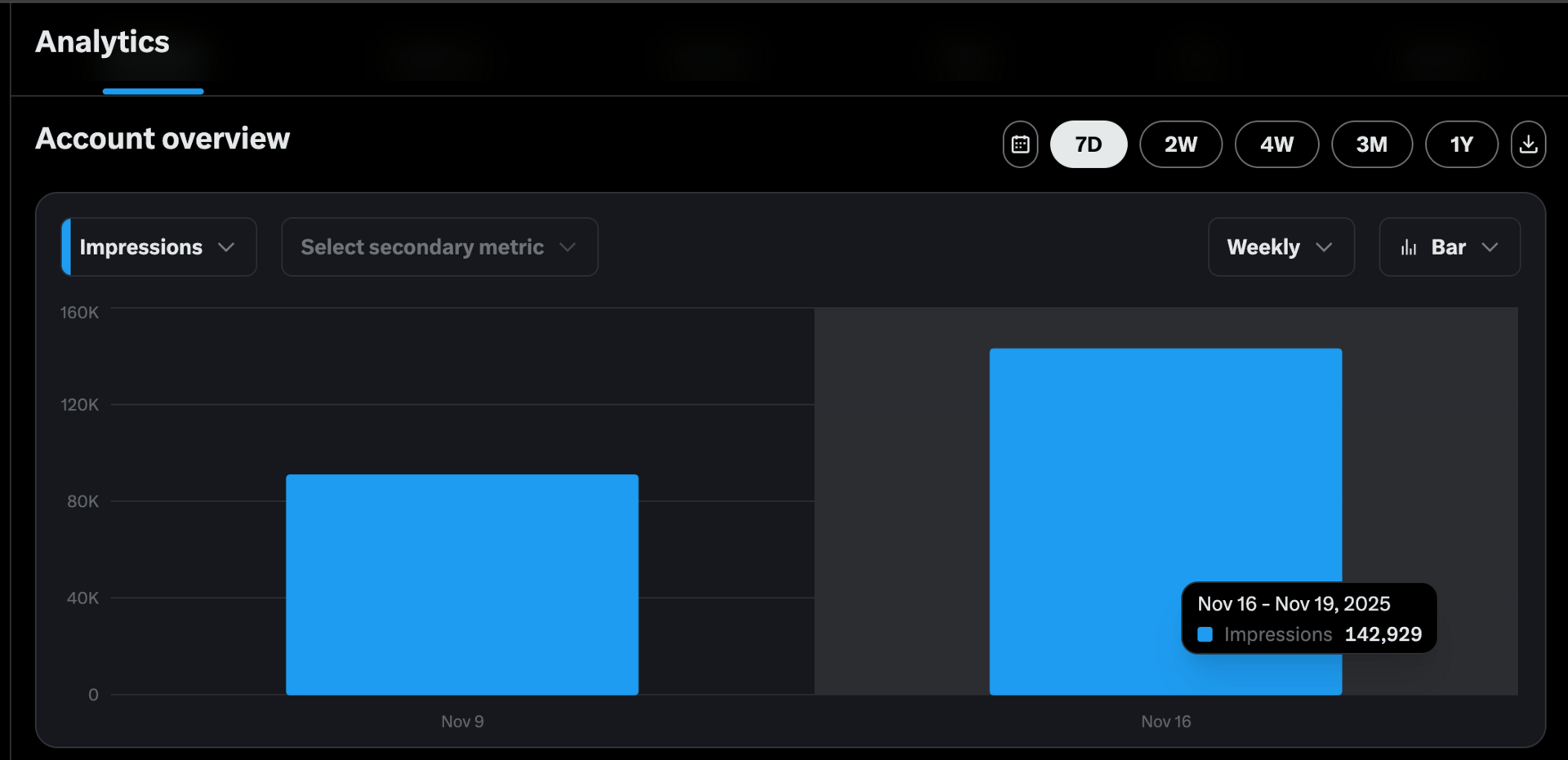This Week's Number
$100,000.
That's how much I save every single year by building from Toronto instead of San Francisco.
Not because Toronto is cheap (it isn't). But because San Francisco is insane.
I have the same quality of life. The same product output. But I'm doing it with five people instead of fifty.
And we're outcompeting VC-backed teams with millions in the bank.
Ten years ago, the startup playbook was simple: raise millions, hire fast, move to SF, scale or die.
That playbook is now a death trap.
The old rules died when ChatGPT launched in November 2022. If you're still trying to hire 20 people and rent an office in SoMa to look ‘legit’, you're playing a game that no longer exists.
Here's the new framework for 2025:
Capital, Code, Audience.
1. Capital (Liquidity > Amount Raised)
The Old Way: Raise $5M. Hire 20 people immediately to show ‘growth’. Get a WeWork. Burn $400K/month. Pray for product-market fit before the cash runs out.
The New Way: Keep costs near zero. Focus on recurring revenue from day one. Stay alive long enough to be right.
I'm not the only one seeing this.
The Downsize-and-Win Path
Look at Sahil Lavingia, founder of Gumroad.
A few years ago, Gumroad had a massive team and burned cash chasing ‘unicorn status.’ It almost killed the company.
Sahil made a brutal pivot: he cut the company down to five people.
The result? Gumroad is now more profitable than ever, generating millions in revenue with a team small enough to fit in a Honda Civic.
The Bootstrap-to-Billions Path
Or look at Mailchimp.
Never raised VC. Grew to $800M in annual revenue. Sold to Intuit for $12 billion in 2021.
The two founders - Ben Chestnut and Dan Kurzius - owned roughly 50% each. That means they kept 100% of the equity between them.
After taxes, each founder personally cleared around $5 billion.
Compare that to the average VC-backed exit:
Raise 3-4 rounds
Get diluted down to 10-20% ownership
Sell for $12B
Founders walk with $1-2B each (still rich, but you gave away $10B)
Mailchimp's founders kept it all.
The Danger of the ‘Old Way’
If you think raising millions is the answer, look at Atrium.
Founded by Justin Kan (Twitch co-founder, Former Y Combinator partner).
Raised: $75 Million.
Hired: 100+ lawyers and staff.
Outcome: Shut down completely in 2020.
Why? Because they tried to be a high-growth tech company with a high-cost human service model.
Here's the brutal math:
100 employees × $150K average = $15M/year in salaries alone
Add office, benefits, recruiting: $20M+/year burn
With $75M raised, they had less than 4 years of runway
And zero room to pivot
When they realized the model was broken, they had about 3 months of runway left. With 100 people on payroll, they couldn't pivot fast enough. Dead in 90 days.
If a YC partner with $75M can't make the ‘bloated headcount’ model work, why do you think you can?
Sahil proved you can downsize and win. Mailchimp proved you can bootstrap to billions. Atrium proved the VC path can kill even the best founders.
Which story do you want to be?
My Reality
At SimpleDirect, we have 50+ months of runway. Not because we raised a Series B, but because we're efficient as hell.
Small teams can survive 10+ years on the same capital that gives big teams 2-3 years.
The longer your runway, the more freedom you have to pivot when something doesn't work.
2. Code (Directing > Writing)
The most dangerous excuse in 2025 is: "I'm not technical, I need a CTO."
Reality Check: You don't need a technical co-founder. You need to know how to direct AI.
Think of a film director vs. a cameraman.
The director doesn't hold the camera. They don't adjust the focus ring. But they know exactly what the shot should look like, and they know if the cameraman got it right.
That is you with AI.
Cursor is your cameraman (writing the code)
Claude is your cinematographer (planning the architecture)
You are the Director (approving the output)
The ‘Non-Technical’ Advantage
You don't even need to be a coder to build a tech company.
Look at Tim Westergren, founder of Pandora.
Tim wasn't a hacker. He was a musician and a male nanny.
He didn't write the code; he built the ‘Music Genome Project’ - the logic and taste behind the algorithm. He directed the technical team on what to build based on his domain expertise.
In 2025, AI is your technical team. Your job is to have the taste and the domain expertise to tell it what to do.
Proof It Works Today
Look at Danny Postma.
He's a designer, not a hardcore engineer. He built HeadshotPro - an AI headshot generator - completely solo using AI tools.
Team: 1 person.
VC Money: $0.
Result: Hit $1M ARR in roughly 6 months.
He didn't hire a dev shop. He didn't find a "tech co-founder." He used AI to leverage his own time.
The barrier isn't technical anymore. It's courage.
Are you willing to look stupid asking Claude basic questions?
Because that's what it takes. And the founders who swallow their pride and ask anyway? They're shipping products in weeks that used to take years.
My Stack
Cursor – My primary dev tool. Free tier. Tell it what to build, review the code, approve or reject. I treat it like a junior developer who needs oversight.
Claude – Strategy, content, problem-solving, brainstorming. I told Claude to ‘be brutally honest with me’ and it acts like the co-founder I never had.
Chatwoot – Automates 90%+ of customer support. (Could be Intercom, Help Scout, whatever. Pick the cheapest one.)
GitHub Copilot – Code suggestions in real-time.
MCP Servers – Gives AI context about my business so it understands complexity without me explaining everything from scratch.
The key: Before you hire anyone or bring on another co-founder, ask: Can AI + a contractor do this?
If yes, you just saved yourself equity and complexity.
3. Audience (Trust > Traffic)
When I say "Audience," people hear "Influencer."
Wrong.
Audience is Distribution Liquidity.
If you don't have an audience, you have to pay a toll to Google or Meta every time you want to speak to a customer. You're renting access to their users.
If you do have an audience, you own the road.
The Power of Audience-First
Look at Copy.ai.
Before they launched, the founders built in public on Twitter. They shared demos, wins, and roadmap updates daily.
Launch Day: They didn't hear crickets. They had an army.
Month 1: 8,000 users and $3,000+ MRR immediately.
Zero ad spend. Pure distribution liquidity.
The ‘No Audience’ Death Spiral
Here's how it goes:
Build product in secret (12 months)
Launch to zero audience
Panic and dump $20-50K into Facebook/Google Ads
Get clicks, not customers (wrong audience)
Burn through runway before finding PMF
Shut down
I've watched this happen to dozens of founders in the past 3 years.
Look at the confessions on Reddit right now:
One founder spent $2,000 on ads and ended up with a few signups and zero paying customers.
Another burned a similar amount, got a handful of signups, and still no conversions.
Another ran a small $50 test, got hundreds of clicks, and zero signups.
Their products weren't bad. Their distribution was broken.
Head to r/SaaS right now. Search "spent ads no customers." You'll find dozens of these confessions every month.
The pattern is always the same:
Build in secret → Launch to silence → Panic spend on ads → Wrong audience → Burn runway → Shut down.
Break the pattern. Build audience first.
My Distribution Without Permission
Without audience:
I send 200 cold LinkedIn DMs
I get 2 responses
I feel miserable
With audience:
I tweet about SimpleDirect or ANC
I get 150,000 impressions
Qualified leads DM me

A glimpse of my Twitter performance, $0 ad spent. Not always consistent, but it works if you can be consistent.
I don't need TechCrunch to write about me. I don't need a PR agency ($5K/month I almost wasted). I don't need YC to validate me.
I already have people who opted in to hear what I say.
The Rented vs. Owned Strategy
Start with rented platforms (Twitter, LinkedIn) where the people are and algorithms can help you grow.
Transition to owned channels (Newsletter, Podcast) where you control the relationship directly.
Launch to people who already trust you.
I spent 2019-2023 keeping my head down. That was my biggest regret. If I had started building in public earlier, everything would have been easier.
Don't make my mistake. Start today.
The Geography Math (Why I'm in Toronto)
The old playbook said you had to be in SF to "be in the flow."
That worked when information moved slowly. Now, information is instant.
I ran the math on Toronto vs. SF:
Expense | San Francisco | Toronto | Savings |
|---|---|---|---|
Rent (2BR) | $4,500 USD | $2,500 USD | $24k/yr |
Senior Dev | $180,000 USD | $110,000 CAD | $50k/yr |
Founder Burn | $3,000/mo | $1,500/mo | $18k/yr |
TOTAL | ~$100k/yr |
That $100K isn't just ‘savings’. It is survival.
$100K = 10 extra months of runway.
$100K = 2 more pivot attempts.
$100K = The difference between folding and finding product-market fit.
But Can You Build a Unicorn Remotely?
Ask Automattic (WordPress).
Valuation: $7.5 Billion.
Employees: 2,000+.
Offices: Zero.
They have employees in 96 countries. They saved hundreds of millions of dollars by not paying SF commercial rent. That's money they put into product, not landlords.
Or look at Transistor.fm (podcast hosting).
(Side note: I personally use them for my podcast - Founder Reality)
Justin Jackson built it from Vernon, Canada - population 45,000. Jon Buda works from Chicago.
They started in 2018, run a tiny remote team, serve tens of thousands of podcasts, and generate millions in annual revenue.
The ‘you must be in SF’ narrative is dead.
The Bottom Line
Legacy advice says: Scale headcount. Move to the hub. Raise the round.
That advice is designed to optimize for VC outcomes, not Founder outcomes.
The graveyard is full of companies like Atrium that followed that advice off a cliff.
In 2025, the winner isn't the one with the biggest office. It's the one with:
Capital that lasts
Code directed by domain experts (you)
Audience that trusts them
This Week's Action: The "Three C's" Audit
Capital (10 mins)
Open your bank account right now. Divide cash by monthly burn.
If it's under 12 months, name ONE expense you can cut this week to gain 3+ months of runway.
Code (5 mins)
Are you telling yourself you "can't build that"?
Go to Cursor. Type in what you want. See what happens. Be the Director, not the cameraman.
Audience (2 mins)
If you posted "I'm launching X next week" right now, how many people would see it WITHOUT paid ads?
If under 100: Start posting daily on ONE platform. Today.
Fix what's broken. Build the future.
—George
P.S. — I wrote a free 350-page book on this exact playbook. Covers the consulting-first model, bootstrap path, and how to build without VC. Grab it here.
P.P.S. — All frameworks (Three C's, Sunday Night Test, AI Audit) are on the blog at founderreality.com if you want full breakdowns.

